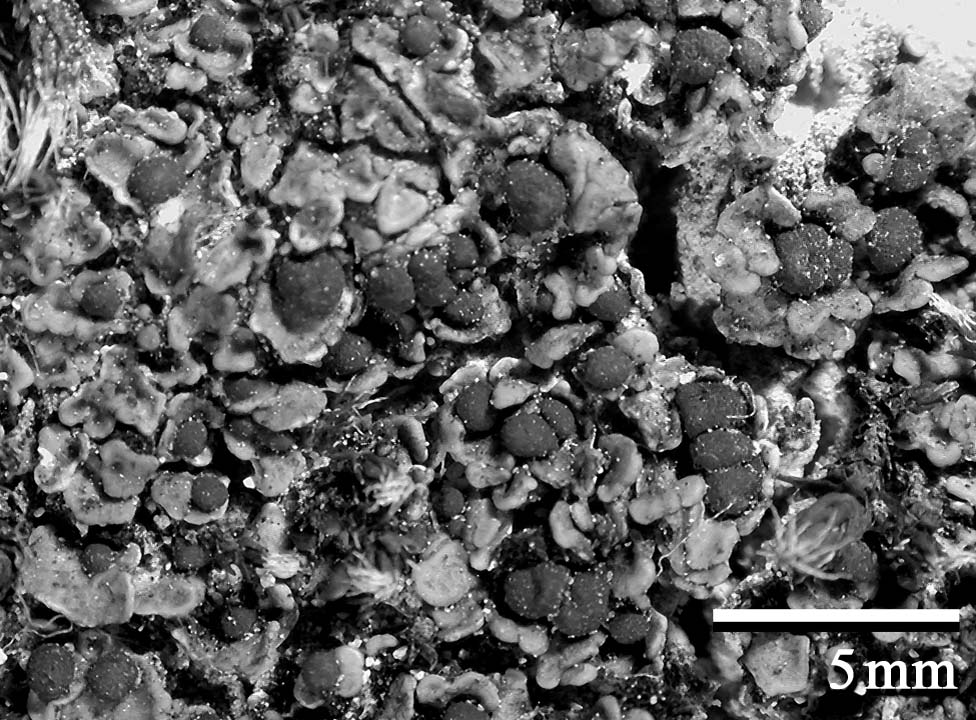
Consortium of Lichen Herbaria
- building a Global Consortium of Bryophytes and Lichens as keystones of cryptobiotic communities -
- Home
- Search
- Images
- Species Checklists
- US States: O-Z >
- US National Parks
- Central America
- South America
- US National Parks
- Southern Subpolar Region
|
Family: Psoraceae |
Nash, T.H., Ryan, B.D., Gries, C., Bungartz, F., (eds.) 2002. Lichen Flora of the Greater Sonoran Desert Region. Vol 1. Life Habit: lichenized, not lichenicolous Thallus: squamulose, attached by the whole lower surface or basal end of squamule squamules: dispersed, adjacent, imbricate, or ascending, 2-10 mm wide, rounded to elongate, with entire, crenulate or lobed margin, without vegetative dispersal units upper surface: from grayish or greenish to dark brown, sometimes red or yellow, dull or shiny, epruinose to densely white pruinose, smooth to deeply fissured upper cortex: varying from 35 to 200 µm thick, containing remnants of algae (chlor-zinc-iodine!), consisting of an upper epinecral layer and a lower stainable layer, the latter composed of thick- to rather thin-walled, anticlinally oriented hyphae with shortly thread-like, angular, or round lumina, often containing lichen substances and/or calcium oxalate medulla: white, of intricately interwoven hyphae, I-, often containing lichen substances and/ or calcium oxalate algal layer: 40-80 µm thick, horizontally continuous photobiont: primary one a chlorococcoid alga, secondary photobiont absent; algal cells: 10-15 µm diam. lower cortex: poorly to well developed, composed of periclinally or anticlinally oriented hyphae, sometimes containing calcium oxalate or anthraquinones lower surface: white to brown Ascomata: apothecial, laminal or marginal, sessile, with a constricted base, simple or rarely somewhat conglomerate, usually convex and immarginate but often plane and indistinctly marginate when young, up to 2 mm diam., brown to black, dull to shiny, epruinose or with yellow or white pruina; exciple: annular, continuous with upper cortex, colorless to pale brown, composed of thick-walled, strongly conglutinated, radiating hyphae; hypothecium: colorless to pale brown, composed of intricately interwoven hyphae densely inspersed by crystals of calcium oxalate and sometimes lichen substances, I-; epithecium: brown, containing brown cell wall pigments and orange crystals of anthraquinones (mainly parietin [polarized light!]), K+ red; hymenium: hyaline, I+ blue, 60-100 µm high; paraphyses: straight, sparingly branched and anastomosing, strongly conglutinated, apical cell slightly swollen asci: clavate, with a well developed, amyloid tholus containing a deeper amyloid tube and lacking an ocular chamber (Porpidia-type), 8-spored ascospores: colorless, simple, ellipsoid, smooth, without halo Conidiomata: pycnidial, laminal, immersed, with colorless or pale brown ostiole, with short, sparingly branched conidiophores conidia: acrogenous, bacilliform Secondary metabolites: anthraquinones, depsides, depsidones, aliphatic acids, pulvinic acids, triterpenes, and usnic acids Geography: arctic to subtropical regions of the world, highest diversity in arid zones Substrate: soil and rock, often calciferous. Notes: The circumscription of the genus is based mainly on the following features: squamulose thallus, anthraquinones in the epithecium, calcium oxalate in the hypothecium, Porpidia-type ascus, immersed, laminal pycnidia and acrogenous, bacilliform conidia (Timdal 1984a). Color reactions caused by compounds located in a brown upper cortex or in a medulla filled with calcium oxalate are difficult to observe, and examination by TLC is crucial for the identification of some species. The five brown species lacking secondary metabolites (P. globifera, P. himalayana, P. luridella, P. pseudorussellii, and P. tuckermanii) form a complex in which some specimens are difficult to identify. |
Powered by Symbiota









